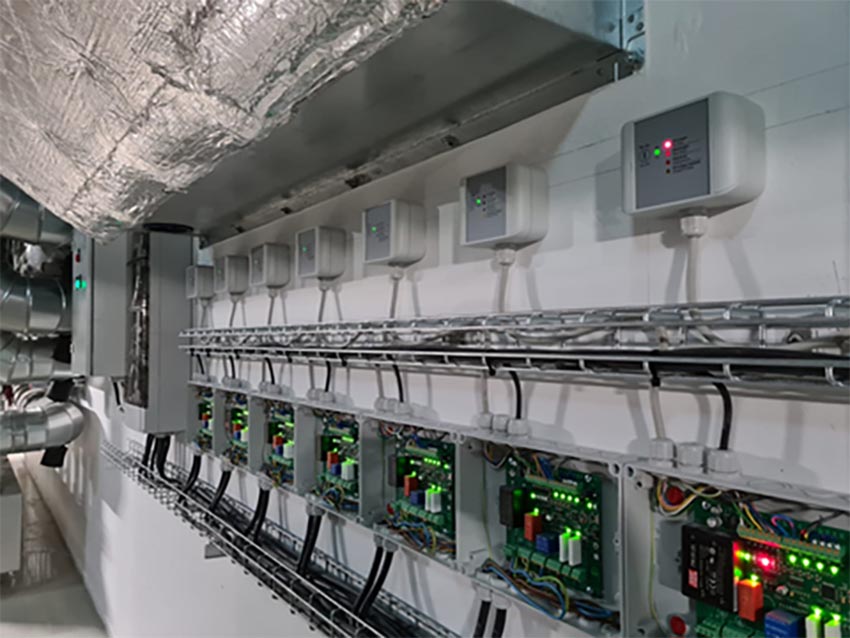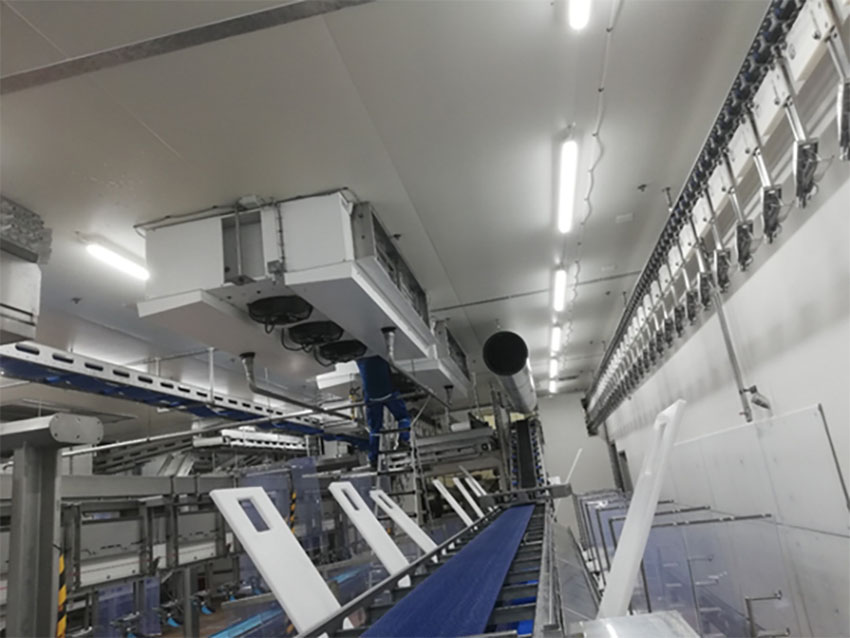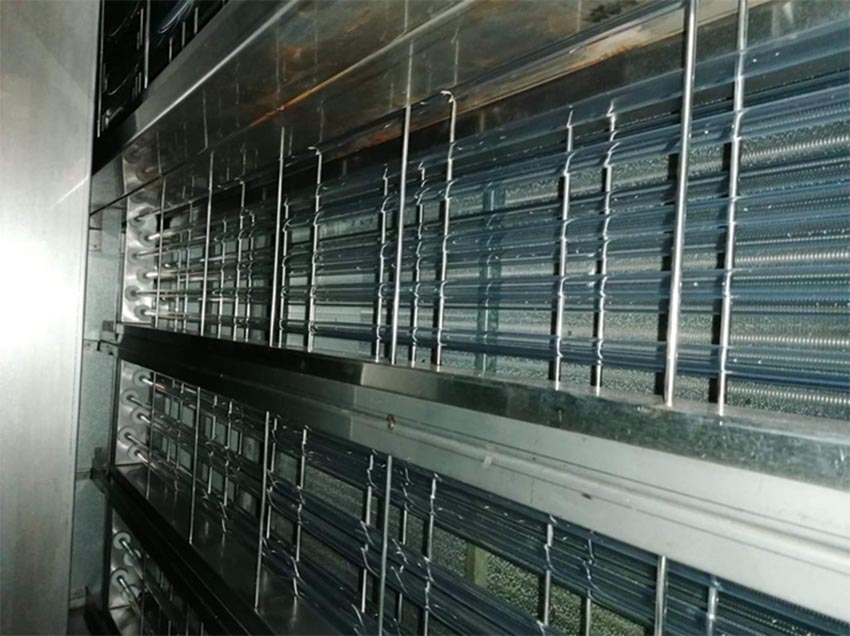Meatproduction companies usually work with an ambient temperature of approx. 10°C. To keep the temperature at this level, only up to 50% of air can be exchanged per hour. This is due to the enormous cooling power which would need to be available for a 100% air exchange. Very often only 10 to 20% of fresh air are possible due to the existing cooling capacity.
Due to this situation, the risk of a corona outbreak caused from one person is increasing in case air is recirculated. The conditions within the meat industry with many people working closely to favour the risk of an outbreak additionally.
Due to this situation various methods of air disinfection e.g. hepa filters or UV-C systems are implemented. With the aim of further improving the air quality in production and extending the minimum shelf life of fresh self-service goods – additionally to the need of protection against Corona, a German meat production company decided in 2020 to install an UV disinfection system from oxytec.
Easy Engineering: What were the needs of the client?
OXYTEC: With the protection against Corona, the customer is ensuring an effective air disinfection and room hygiene according to VDI 6022 and food hygiene regulations. Obviously the system need to be seized on relevant process data such as air temperature, relative humidity, dust load, micro-organism load (qualitative and quantitative analysis), room volume and geometry (including windows and doors), number and frequency of staff, type of products processed and operating parameters of any ventilation systems already in place.

E.E: Why did the client choose your products / solutions?
OXYTEC: UV-C disinfection systems designed for larger production facilities, such as the UV IB from oxytec, ensure that air volumes of unlimited volume can be disinfected economically, depending on the requirements of the customer. The UV IB system can also be easily integrated into existing systems e.g. Air Handling Units in front of vaporizers or cooling coils and can also be installed under the ceiling or at the wall.
A major argument for the use of UV-C disinfection in the meat industry is also the environmental friendliness of this technology. UVC radiation is natural, and there is no need to clean the system with environmentally harmful and cost-intensive chemicals that may subsequently be found on the product. UV-C technology also has advantages towards HEPA filters, which are often used in ventilation systems. This is because Hepa filters usually cause a high pressure loss, which has to be compensated by using more powerful and thus more expensive fans. In contrast, with the same functionality, systems such as the UV IB from oxytec cause a maximum pressure loss of not more than 20 Pa. In addition, Hepa filters are very sensitive to humidity, which again has a negative influence on the Total Bacteria Count within the production facility. Finally Hepa filters only “collect” the virus whereas the UV-C systems are inactivating the virus.

E.E: What products / solutions were used?
OXYTEC: The principle of UV-C disinfection is simple and efficient. Via a fan, room air is sucked into a closed irradiation chamber integrated into the ventilation duct, Air Handling Unit, in front of vaporizers or cooling coils. UV-C low-pressure lamps are integrated with a wavelength of exactly 253.7 nm. When the air is passing the UV-C-lamps the wavelength leads to an effective inactivation of all microorganisms including various viruses. The air is passing through a “UV-C barrier” that fills the cross-section of the channel across the air flow. This ensures that the microorganisms receive the highest possible irradiance and thus a sufficient radiation dose. Due to this arrangement disinfection rates of up to 99% are possible, depending on the requirements. The exact UVC dose that leads to the inactivation of the microorganisms is type-specific and therefore different. While the majority of microorganism including viruses can be inactivated to 99% with relatively low doses between 1 and 30 mWs /cm2, yeasts, moulds and their spores require up to 400 mWs /cm².
E.E: Please describe how was the project implemented?
OXYTEC: The UV IB system from oxytec must be adapted to the existing ventilation system. Relevant process data such as air temperature, relative humidity, dust load, micro-organism load (qualitative and quantitative analysis), room volume and geometry (including windows and doors), frequency of use by staff, type of products processed and operating parameters of the ventilation systems obviously need to be analyzed. Special attention need to be put on the existing ventilation system to check if there is any space for retrofitting UV-C systems within the Air Handling Unit itself or in front of existing vaporisers or cooling coils.

E.E: Were there any products with special characteristics used?
OXYTEC: Harmful ozone formation during the irradiation process in UV-C disinfection systems is prevented by using a special glass that systematically filters the wavelengths below 200 nm that are responsible for ozone formation. UV-C systems with the exact wavelength of 253,7 nm are not causing ozone.
E.E: How important was the project / projects for the client?
OXYTEC: This is very important because UV-C disinfection systems are also an effective way of destroying harmful micro-organisms in the climate chamber before they enter the production area – even in areas with high moisture e.g. in cooling coils. Due to this installation virtually germ-free production conditions can be created, the health of employees can be protected and high hygiene and quality standards can be reliably met.
E.E: What was the client feedback after implementation?
OXYTEC: The main feedback can be summarised as follows:
- The UV-C value (i.e. the radiation emitted) at the retrofitted recirculating air handling units, vaporizers and cooling coils in the filling department and in the slicing department is only 10% of the limit value
- An air volume of 3 x 50,000 m³/h is sterilised in the packaging area- with a positive influence on the indoor air quality and the best-before date.
- Clustering within the Corona pandemic cannot be detected. If a positively tested person (1000 employees are working within the meat factory) is identified, e.g. from the packaging department, all employees of the department are tested; infections to employees working in the same room were not detected after installation of the UV-C systems.
- Out of 40,000 tests (within half a year), there were 0.13% positively tested staff, most of whom are new arrivals or holiday returnees. The installation of the air disinfection modules, which were individually tailored to the respective requirement, took place outside production times and could be done quickly e.g. during the weekend or in the night. The customer was very satisfied with the result.

E.E: How did the solutions provided improve efficiency for the client?
OXYTEC: After a detailed planning phase, an individual sterilisation concept was developed that addresses a total of three neuralgic points in production: In the packaging area, 50,000 m³/h are treated three times before they are dehumidified and cooled via an air-conditioning unit (fresh air proportion approx. 10%). Four evaporators in the filling department with a volumetric air flow per evaporator of 16,940 m³/h (with the corresponding sterilisation attachments) as well as in the packaging and order-picking area, where nine evaporators are sterilised with a respective volumetric air flow of 16,940 m³/h (with the corresponding sterilisation attachments). The control boxes were also installed in all units.
Safety=Efficiency!
E.E: Did the current situation made your company implement differently than usual?
OXYTEC: No. But the demand for economic disinfection systems will be even higher in the future than before due to the Corona pandemic. It is also expected that the demand for the disinfection of Air Handling Units outside of the meat industry will grow. This demand will be driven by the number of people working in ventilated buildings e.g. hotels, offices, logistic centre, public buildings or supermarkets. Currently ventilation systems in those buildings are not working in the air recirculation modus anymore which will have drastic influences on energy costs and thus the CO2 footprint.

